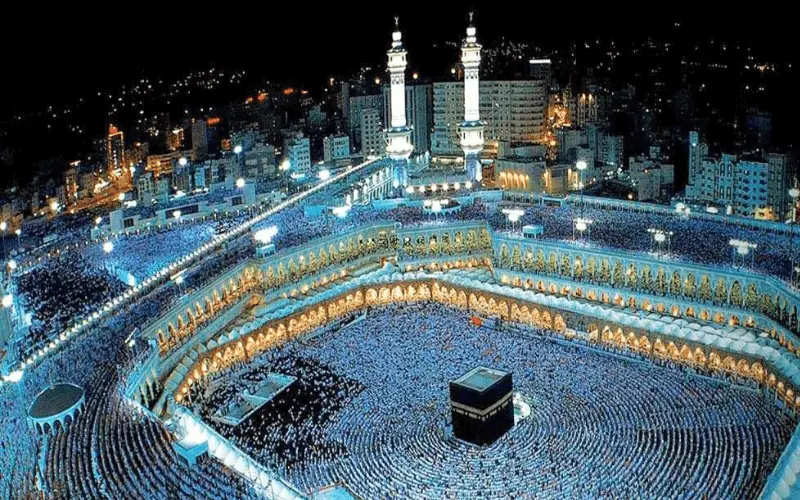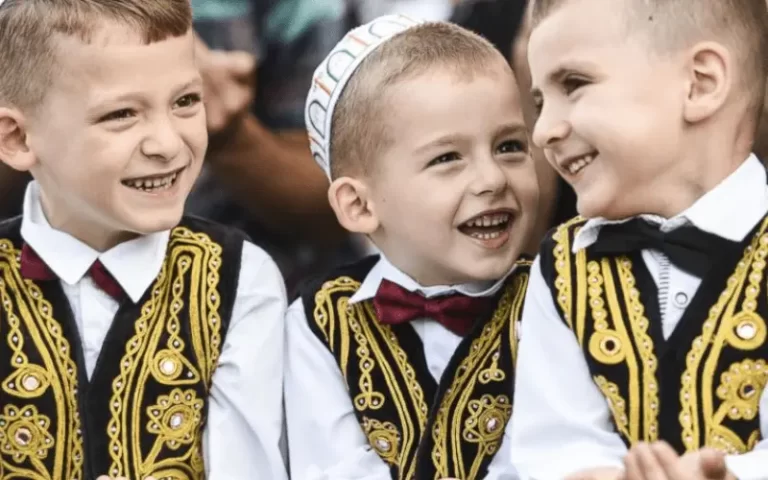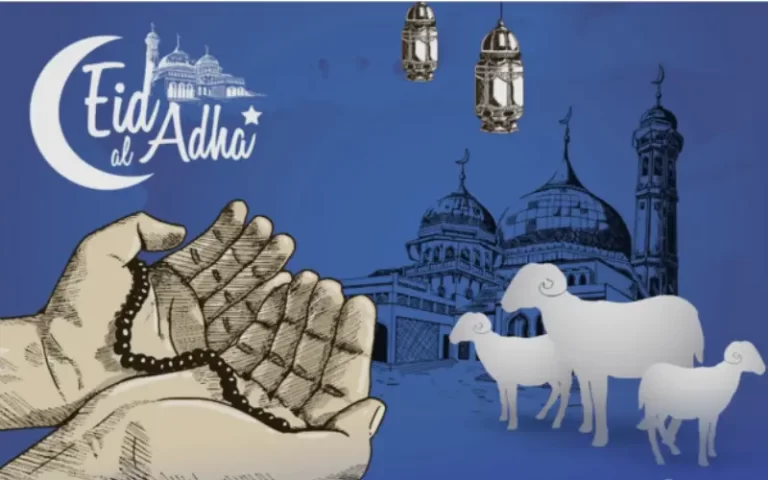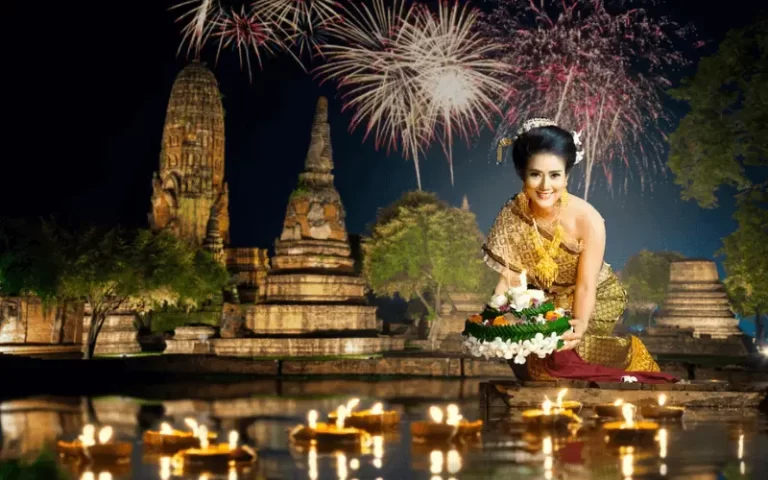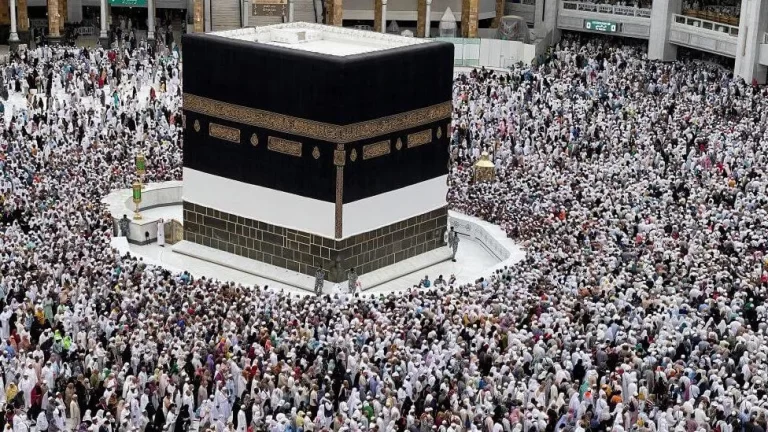Hajj

Every year, millions of Muslims from all over the world travel to Mecca in Saudi Arabia for a special journey called Hajj. The Hajj journey is based on what Prophet Muhammad taught and goes back to the time of Prophet Ibrahim. It’s a special trip that goes beyond time and links Muslims to the history of Islam. It’s a time for people to learn more about themselves, renew their spiritual connection, and come together in worship, no matter where they’re from.
How do Muslims perform Hajj? That’s what this article is about. I’ll be telling you all about this beautiful journey. Just ensure you read this article through to the end.
What’s Hajj?
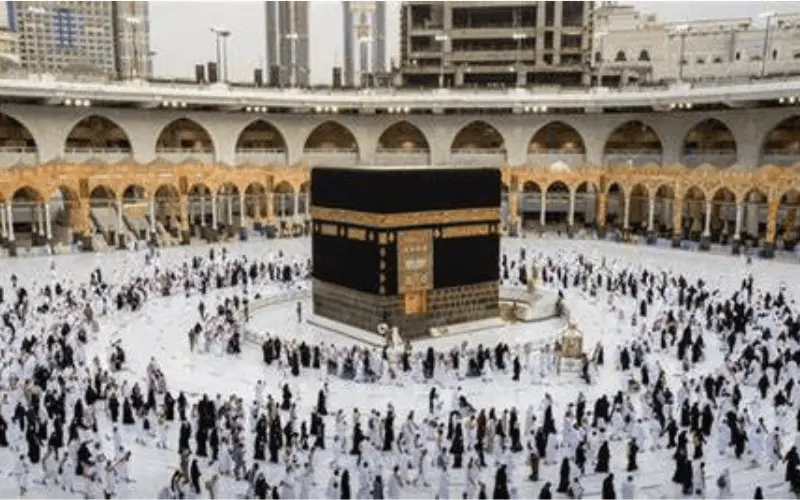
The Hajj, one of the five pillars of Islam, stands as a testament to the enduring strength of faith and the unbreakable bonds of unity within the Muslim community. This journey is very important in Islam. Hajj is performed during the Islamic month of Dhu al-Hijjah, which is the twelfth month of the Islamic lunar calendar. Hajj takes place each year between the 8th and 12th of Dhul Hijjah.
The exact dates of Hajj vary each year because the Islamic calendar is based on the lunar cycle, which is about 11 days shorter than the Gregorian solar calendar. As a result, the timing of Hajj shifts approximately 10 to 12 days earlier each year in the Gregorian calendar.
Hajj must be performed by every Muslim at least once in their lifetime, so long as they are financially, physically, and emotionally able to do so. Going more than once during your lifetime is permitted whilst sincerely seeking Allah’s (SWT) pleasure.
The Hajj comprises many rituals and these rituals are deeply symbolic, reflecting the trials and triumphs of prophets and the essence of submission to the will of Allah. From the circumambulation of the Kaaba, the sacred house of worship believed to have been built by Ibrahim and his son Isma’il (Ishmael), to the symbolic stoning of the pillars representing the rejection of Satan’s temptations, each act carries profound spiritual significance.
Beyond its religious importance, the Hajj serves as a powerful demonstration of the unity of the Muslim ummah (community). Regardless of nationality and social status, pilgrims stand shoulder to shoulder, dressed in simple white garments, equal before their Creator. This sense of equality and solidarity underscores the universal message of Islam, emphasizing the inherent dignity and equality of all humanity.
Moreover, the Hajj fosters a sense of humility and empathy, as pilgrims experience the physical and emotional challenges of the journey together. From the rigorous rituals to the crowded streets of Mecca, each step of the pilgrimage offers opportunities for reflection, repentance, and spiritual growth.
In our connected world today, the Hajj reminds us how important faith is and why we should respect and understand other cultures and religions. When pilgrims go back home, they bring blessings from their journey and a stronger promise to be kind, fair, and peaceful every day.
History of Hajj
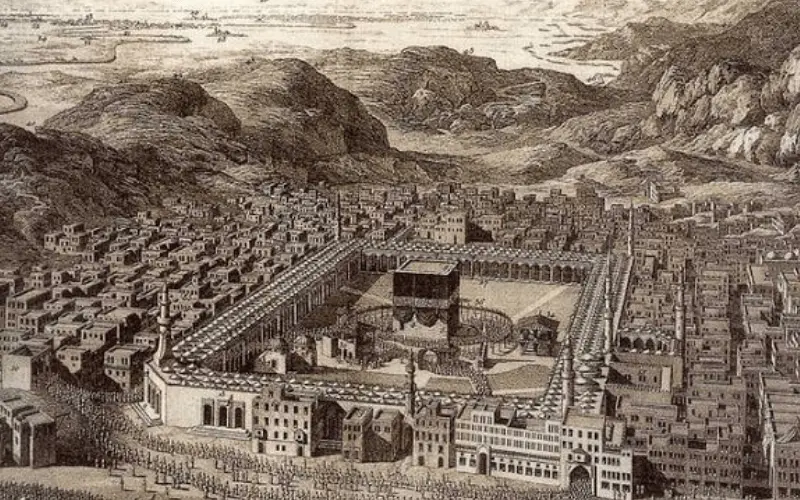
The history of Hajj dates back to the time of the Prophet Ibrahim (Abraham) and his son Isma’il (Ishmael). According to Islamic tradition, Ibrahim was commanded by Allah to build the Kaaba, the sacred house of worship in Mecca. The Kaaba is believed to be the first place of worship dedicated to the worship of one God.
The rituals of Hajj as practiced today trace their origins to the time of Prophet Muhammad, who performed the pilgrimage in the year 632 AD. The Prophet Muhammad’s actions during Hajj serve as a model for Muslims to follow in their pilgrimage.
Over the centuries, Hajj has evolved and expanded, with various rulers and dynasties contributing to its development. Despite political changes and geographical challenges, the pilgrimage has remained a central aspect of Islamic practice, attracting millions of believers from all corners of the globe each year.
Throughout history, the Hajj has played a significant role in shaping the identity and unity of the Muslim community. It serves as a reminder of the shared heritage and spiritual legacy that unites Muslims across diverse cultures and backgrounds.
Steps Performed In Hajj
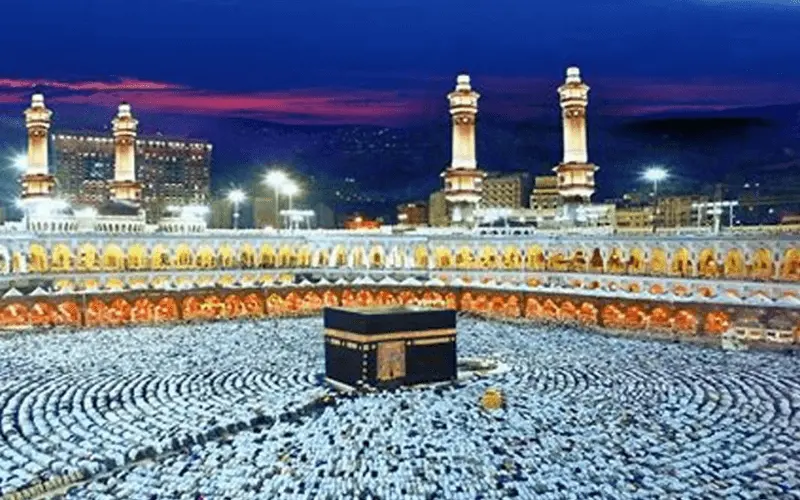
There are three forms of Hajj: Tamattu, Ifraad, and Qiran.
For this Hajj guide, we will use the Tamattu form of Hajj, which is what the Prophet Muhammad (peace and blessings be upon him) encouraged the Muslims to perform.
The Hajj pilgrimage consists of several rituals, each carrying its significance and symbolism. Here are the main steps performed during Hajj:
Now let’s talk about Hajj 5 Days: Step-by-Step Instructions of Dedication
Day 1- Re-entering State of Ihram (8th Dhul Hijjah)
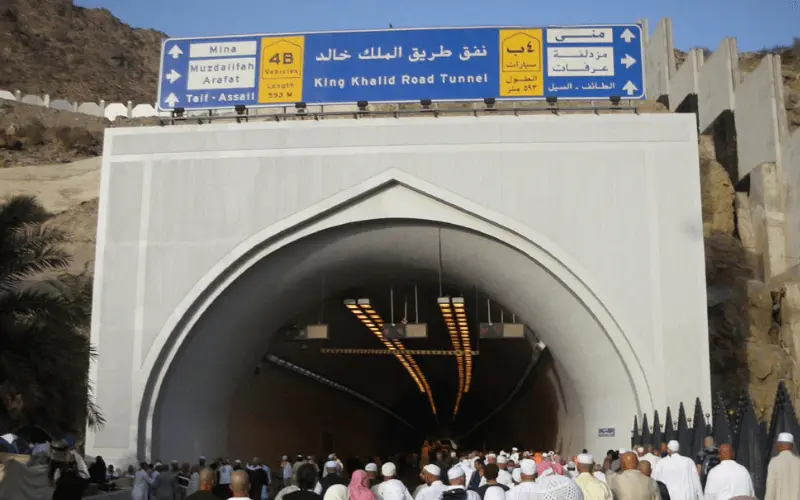
The 8th day of Dhul Hijjah marks the beginning of the days of Hajj. Enter the state of Ihram once again.
Once you’re all set to enter the Ihram, you’ll begin reciting the following invocation called the Talbiyah:
لَبَّيْكَ اللَّهُمَّ لَبَّيْكَ، لَبَّيْكَ لاَ شَرِيْكَ لَكَ لَبَّيْكَ، إِنَّ الْحَمْدَ وَالنِّعْمَةَ لَكَ وَالْمُلْكَ لاَشَرِيْكَ لَكَ
Transliteration: Labbayka Allāhumma labbayk. Labbayk lā shareeka laka labbayk. Inna al-ḥamda, wa n-‘imata, Laka wal mulk. Lā shareeka lak.
Translation: “Here I am, O Allah, here I am, here I am. You have no partner, here I am. Verily all praise and blessings are Yours and all sovereignty. You have no partner.”
You will then proceed with your Hajj group to the neighborhood of Mina in Makkah, which is located roughly eight kilometers from the center of Makkah.
Arrive At Mina
Once you arrive in the tent city (neighborhood) of Mina, you’ll settle into your allocated tent. Here you’ll pray Salah (obligatory prayers), including Dhuhr, Asr, Maghrib, ‘Isha, and Fajr, shortening your four-unit prayers to two units each, without combining them, as stated in the Qu’ran.
You’ll spend the night praying to Allah (SWT), reading the Qur’an, and preparing for day two. It’s an important time for spiritual reflection and devotion, so try and make the most of this special night.
Day 2 – Day of Arafah (9th Dhul Hijjah)

After sunrise in Mina, pilgrims proceed to the expansive plains of ‘Arafah. Here, they engage in the recitation of Istaghfar (seeking forgiveness) and offer supplications, observing the Day of ‘Arafah as a time dedicated to seeking forgiveness from Allah for their sins.
Upon arrival at the plains of Mount ‘Arafah, pilgrims perform a shortened combined Dhuhr and Asr prayer, consisting of two rakats instead of the usual four.
On this day, a sermon will be delivered from Masjid al-Nimra on Mount ‘Arafah.
The Day of ‘Arafah holds immense significance for Muslims globally, as Allah (SWT) describes it in Surah al-Maidah as the day when He perfected the religion, bestowed His blessings upon Prophet Muhammad (peace and blessings be upon him), and affirmed Islam as the chosen way of life.
The Prophet (peace and blessings be upon him) also said:
There is no day on which Allah frees people from the Fire more so than on the day of ‘Arafah. He comes close to those (people standing on ‘Arafah), and then He reveals before His Angels saying, ‘What are these people seeking. (Hadith | Muslim)
Arrive in Muzdalifah
After the sun sets, you will leave ‘Arafah and journey towards Muzdalifah, which lies as an open plain between Mina and ‘Arafah. Upon reaching Muzdalifah, you will consecutively offer your Maghrib and ‘Isha prayers, shortening the ‘Isha prayer to two Rakat.
As Abdullah ibn Umar (RA) narrates:
The Prophet (peace and blessings be upon him) offered the Maghrib and ‘Isha prayers together at Muzdalifah with a separate Iqamah (second call to prayer) for each of them and did not offer any optional prayer in between them or after each of them. (Hadith | Bukhari)
Afterward, you can spend the night in worship or resting.
While staying in Muzdalifah, you have the opportunity to gather small stones for the ritual of Rami(the stoning of the devil) over the next three days. The size of the pebbles should be similar to the size of date stones/seeds. You will need a total of 49 pebbles.
Day 3 – Rami And Hady (10th Dhul Hijjah & Start Of Eid al-Adha)

The 10th day of Dhul Hijjah, known as Yawm al-Nahr or the Day of Sacrifice (Qurbani), is marked by the ritual slaughter of animals.
Following the Fajr prayer, you will leave Muzdalifah and return to Mina, ensuring to maintain the continuous recitation of the Talbiyah.
On this day, pilgrims carry out the Hady (sacrificial animal) ritual and begin the first of three days of the “stoning of the devil” ceremony, known as Rami. Additionally, Muslims worldwide offer Qurbani and initiate the four-day celebration of Eid al-Adha.
We know this from this verse in the Qur’an:
And when you are safe, then, whoever avails the advantage of the ‘Umrah along with the Hajj shall make an offering of whatever animal is available. However, anyone who finds none shall fast for three days during Hajj, and for seven days when you return; thus they are ten in all. This is for him whose family folk are not residents of Al-Masjid-ul-Harām. Qur’an | 2:196
Origin of Rami(The Stoning of the Devil)
The stoning ritual, also known as the ‘stoning of the devil’, is performed by Hajj pilgrims in Mina over three days, during which they throw pebbles at three stone structures.
The initial day of stoning falls on the 10th of Dhul Hijjah. On this day Muslims also offer Qurbani and celebrate Eid al-Adha.
The throwing of stones at the Jamarat is called Rami. This ritual symbolizes the actions of Ibrahim (AS) when he was tested with the command from Allah (SWT) to sacrifice his son, Isma’il (AS).
During Ibrahim’s (AS) journey to fulfill Allah’s command, Satan (Iblis) persistently attempted to lure him into disobedience. Upon reaching Jamarat al-Aqaba, Allah commanded the Angel Jibreel (AS) to direct Ibrahim (AS) to cast seven stones at Satan. Ibrahim complied, causing Satan to flee instantly. The three Jamarat represent the locations where Satan tried to deter Ibrahim from obeying Allah’s command.
How To Perform The Rami (The Stoning Of The Devil)
During the 10th, 11th, and 12th days of Dhul Hijjah, you will participate in the ritual of Rami, also known as the stoning of the devil. The pebbles used should be approximately the size of date stones or seeds. You will require a total of 49 pebbles.
For each of the three days, you’ll require a specific number of pebbles. Here’s the breakdown:
- 7 pebbles for the 10th of Dhul Hijjah
- 21 pebbles for the 11th of Dhul Hijjah
- 21 pebbles for the 12th of Dhul Hijjah
When you arrive at the Jamarat, go directly to the biggest pillar called Jamarat al-Aqaba. Here, you’ll throw the first seven pebbles at this concrete pillar. Remember, you only need to throw stones at this pillar on the first day.
Upon each throw, you should recite the Takbir:
“اللهُ أَكْبَرُ”
Transliteration:
“Allāhu ‘Akbar”
Translation:
“Allah is The Greatest”
Qurbani and Eid al-Adha
Muslims worldwide celebrate the festival of Eid al-Adha on the 10th of Dhul Hijjah, even those who are not on pilgrimage. Through the act of offering Qurbani (sacrifice), Muslims commemorate Prophet Ibrahim’s (AS) readiness to sacrifice his son Isma’il (AS) in obedience to Allah’s command.
Day 4 – Shaving The Head (11th Dhul Hijjah)

Following the offering of the Hady, males should shave or trim their hair, with shaving being the preferred practice, as demonstrated by Prophet Muhammad (peace and blessings be upon him). Females should trim their hair to the length of a fingertip.
Now, you are permitted to exit the state of Ihram and dress in comfortable attire. You may also resume engaging in activities that were previously restricted during Ihram, except for sexual intimacy. Following the Sunnah of Prophet Muhammad (peace and blessings be upon him), it is recommended to apply perfume, as he was known to have a pleasant scent of musk at this stage.
Day 5 – Tawaf al-Ifadha and Saai (12th Dhul Hijjah)

Next, you will proceed to Makkah to perform Tawaf al-Ifadha, followed by another round of Saai as part of your Hajj rituals.
Performing Tawaf al-Ifada and Sa’i is mandatory. You must complete Tawaf al-Ifada and Sa’i after completing the stoning ritual, the Qurbani (sacrifice), and shaving or trimming your hair.
Upon finishing the Tawaf and Sa’i, you can now unwind and participate in all permissible activities that were allowed before entering the state of Ihram, including marital relations.
Nevertheless, you will return to your tents in Mina and proceed with the remaining rituals of Hajj.
The Second Day of Rami
On the 11th of Dhul Hijjah, you will move on to your second day of Rami(the stoning of the devil).
During this occasion, you will throw stones at each of the three pillars in sequence. You will start with Jamarah al-Ula (the small pillar), followed by Jamarah al-Wusta (the middle pillar), and finally, Jamarah al-Aqaba (the large pillar). After stoning the first and second pillars, pause to make Du’a face the qibla. Each pillar should be struck with seven consecutive pebbles while reciting the Takbir.
Spend the night in Mina
Once your second Rami is completed, you’ll head back to your camp in Mina and devote the rest of the day and night to worship.
The Third Day of Rami
In the afternoon of the 12th of Dhul Hijjah, you’ll prepare your last set of pebbles (21 in total) to follow the same procedure as the day before.
Tawaf al-Wida (The Farewell Tawaf)

Now, there is only one remaining task before concluding Hajj and leaving Makkah: the farewell Tawaf, which is the final ritual that Muslims must undertake.
Ibn Abbas (RA) narrated:
The people were ordered to perform the Tawaf al-Wida as the last thing before leaving (Makkah), except the menstruating women who were excused.
For the farewell Tawaf, you will circle the Kaaba seven times, followed by performing two Rakat of Salah and drinking Zam Zam water. Unlike previous rituals, there is no Sa’i or shaving/trimming of the head after completing this Tawaf.
These are the main steps of Hajj, each carrying profound spiritual significance and reflecting the journey of faith and submission to Allah.
Quranic Ayats Related to Hajj
Here are some Quranic verses (Ayats) related to Hajj:
وَأَتِمُّوا الْحَجَّ وَالْعُمْرَةَ لِلَّهِ ۚ فَإِنْ أُحْصِرْتُمْ فَمَا اسْتَيْسَرَ مِنَ الْهَدْيِ ۖ وَلَا تَحْلِقُوا رُءُوسَكُمْ حَتَّىٰ يَبْلُغَ الْهَدْيُ مَحِلَّهُ ۚ فَمَنْ كَانَ مِنْكُمْ مَرِيضًا أَوْ بِهِ أَذًى مِّن رَّأْسِهِ فَفِدْيَةٌ مِّن صِيَامٍ أَوْ صَدَقَةٍ أَوْ نُسُكٍ ۚ فَإِذَا أَمِنتُمْ فَمَن تَمَتَّعَ بِالْعُمْرَةِ إِلَى الْحَجِّ فَمَا اسْتَيْسَرَ مِنَ الْهَدْيِ ۚ فَمَن لَّمْ يَجِدْ فَصِيَامُ ثَلَاثَةِ أَيَّامٍ فِي الْحَجِّ وَسَبْعَةٍ إِذَا رَجَعْتُمْ ۗ تِلْكَ عَشَرَةٌ كَامِلَةٌ ۗ ذَٰلِكَ لِمَن لَّمْ يَكُنْ أَهْلُهُ حَاضِرِي الْمَسْجِدِ الْحَرَامِ ۚ وَاتَّقُوا اللَّهَ وَاعْلَمُوا أَنَّ اللَّهَ شَدِيدُ الْعِقَاب
Translation:
“And complete the Hajj and ‘Umrah for Allah. But if you are prevented, then [offer] what can be obtained with ease of sacrificial animals. And do not shave your head until the sacrificial animal has reached its place of slaughter. And whoever among you is ill or has an ailment of the head [making shaving necessary must offer] a ransom of fasting [three days] or charity or sacrifice. And when you are secure, then whoever performs ‘Umrah [during the Hajj months] followed by Hajj [offers] what can be obtained with ease of sacrificial animals. And whoever cannot find [or afford such an animal] – then a fast of three days during Hajj and of seven when you have returned [home]. Those are ten complete [days]. This is for those whose family is not in the area of al-Masjid al-Haram. And fear Allah and know that Allah is severe in penalty.” Surah Al-Baqarah (2:196)
الْحَجُّ أَشْهُرٌ مَّعْلُومَاتٌ ۚ فَمَن فَرَضَ فِيهِنَّ الْحَجَّ فَلَا رَفَثَ وَلَا فُسُوقَ وَلَا جِدَالَ فِي الْحَجِّ ۗ وَمَا تَفْعَلُوا مِنْ خَيْرٍ يَعْلَمْهُ اللَّهُ ۗ وَتَزَوَّدُوا فَإِنَّ خَيْرَ الزَّادِ التَّقْوَىٰ ۚ وَاتَّقُونِ يَا أُولِي الْأَلْبَابِ
Translation:
The Hajj is [during] well-known months, so whoever has made Hajj obligatory upon himself therein [by entering the state of ihram], there is [to be for him] no sexual relations and no disobedience and no disputing during Hajj. And whatever good you do – Allah knows it. And take provisions, but indeed, the best provision is fear of Allah. And fear Me, O you of understanding. Surah Al-Baqarah (2:197)
لَيۡسَ عَلَيۡكُمۡ جُنَاحٌ أَن تَبۡتَغُواْ فَضۡلٗا مِّن رَّبِّكُمۡۚ فَإِذَآ أَفَضۡتُم مِّنۡ عَرَفَٰتٖ فَٱذۡكُرُواْ ٱللَّهَ عِندَ ٱلۡمَشۡعَرِ ٱلۡحَرَامِۖ وَٱذۡكُرُوهُ كَمَا هَدَىٰكُمۡ وَإِن كُنتُم مِّن قَبۡلِهِۦ لَمِنَ ٱلضَّآلِّينَ
There is no blame upon you for seeking bounty from your Lord [during Hajj]. But when you depart from ‘Arafat, remember Allah at al-Mash’ar al-Haram. And remember Him, as He has guided you, for indeed, you were before that among those astray. Surah Al-Baqarah (2:198)
ثُمَّ أَفِيضُواْ مِنۡ حَيۡثُ أَفَاضَ ٱلنَّاسُ وَٱسۡتَغۡفِرُواْ ٱللَّهَۚ إِنَّ ٱللَّهَ غَفُورٞ رَّحِيمٞ
Then depart from the place from where [all] the people depart and ask forgiveness of Allah. Indeed, Allah is Forgiving and Merciful. Surah Al-Baqarah (2:199)
These verses provide guidance and regulations related to the performance of Hajj, including the rituals, obligations, and spiritual significance associated with the pilgrimage.
Hadith Related to Hajj
Here are some Hadiths (sayings of the Prophet Muhammad) related to Hajj:
Narrated by Abu Huraira (may Allah be pleased with him):
The Prophet Muhammad (peace be upon him) said, “Whoever performs Hajj for Allah’s pleasure and does not have sexual relations with his wife, and does not do evil or sins then he will return (after Hajj free from all sins) as if he were born anew.” (Sahih Bukhari, Book 26, Hadith 596)
Narrated by Abu Huraira (may Allah be pleased with him):
The Prophet Muhammad (peace be upon him) said, “The performance of ‘Umrah is an expiation for the sins committed between it and the previous ‘Umrah; and the reward of Hajj Mabrur (i.e., one accepted) is nothing but Paradise.” (Sahih Bukhari, Book 26, Hadith 595)
Narrated by Abu Huraira (may Allah be pleased with him):
Allah’s Messenger (peace be upon him) said, “Whoever performs Hajj and does not commit any obscenity or transgression will return [free from sins] as he was on the day his mother gave birth to him.” (Sahih Bukhari, Book 26, Hadith 594)
Narrated by Abu Huraira (may Allah be pleased with him):
The Prophet Muhammad (peace be upon him) said, “O Allah! I seek refuge with You from committing a sin or doing oppression, from being afflicted with poverty or being overtaken by debt, and from being overpowered by others or overpowered by (other) people.” (Sahih Bukhari, Book 26, Hadith 593)
These Hadiths highlight the significance of performing Hajj sincerely for the sake of Allah, avoiding sins during the pilgrimage, and seeking forgiveness and purification through the journey.
FREQUENTLY ASKED QUESTIONS
Who performed the first Hajj in the world?
Muslims hold the belief that the practices observed during the Hajj pilgrimage trace back to the era of the Prophet Ibrahim (Abraham). In 632 CE, the year of his passing, Prophet Muhammad himself guided the Hajj rituals. Presently, the annual Hajj pilgrimage draws approximately three million pilgrims from various corners of the globe.
On which date Hajj 2024 will be performed?
Hajj takes place each year between the 8th and 12th of Dhul Hijjah. Muslims use the lunar calendar, so the corresponding Gregorian date will vary from year to year. The Hajj pilgrimage of 2024 is scheduled to occur from Friday, June 14th, to Wednesday, June 19th, encompassing these dates.
What is the Hajj pillar?
Hajj, the pilgrimage to Makkah, is the fifth pillar and the most significant manifestation of Islamic faith and unity in the world. For those Muslims who are physically and financially able to make the journey to Makkah, the Hajj is a once-in-a-lifetime duty that is the peak of their religious life.
Is the Hajj a jihad?
Narrated ‘Hazrat Aisha: The Prophet was asked by his wives about the Jihad and he replied, “The best Jihad (for you) is (the performance of) Hajj.”
How long does the Hajj last?
The Hajj pilgrimage is performed over five to six days, from the 8th to the 12th or 13th of Dhul Hijjah. When the new crescent moon is sighted, Eid al-Adha begins.

